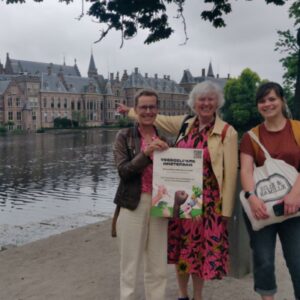
We krijgen onverminderd veel steun van onze volgers, donateurs, én ambassadeurs zoals Kate Brown. Zij schreef onlangs een boekreview voor de Washington Post, over twee interessante boeken die aandacht hebben voor de ontwikkeling van stadsnatuur in steden.
In dat laatste boek wordt een optimistisch beeld beschreven van Amsterdam als groene parel en koploper op het gebied van natuurinclusief leven in de stedelijke omgeving. Maar Kate beargumenteert dat dit beeld helaas verre van klopt.
“Both authors call for city dwellers to get to know their urban nature better with the rationale that what is good for urban wildlife is good for humans. However, Wilson’s roaming narrative, hopping quickly from place to place, undermines that message. He points, for example, to Amsterdam as the center of a new, emerald-green revolution in urban living. As he optimistically notes, city leaders have pledged to make Amsterdam energy self-sufficient and zero-waste by 2050, while consuming food from a belt around the urban center.
It is easy to make the technophilic Dutch the centerpiece of a hopeful future, but there is not much truth to it. Having lived in Amsterdam for the past year researching urban agriculture and food sovereignty movements, I can attest that Wilson’s soothing message about efficient technocracy riding in on a white horse to save overheated, flood-prone cities is a fantasy. The Netherlands has a massive nitrogen crisis with emissions far exceeding European Union regulations. In the past four years, Dutch forests have shrunk, and the planting of new trees has decelerated.
The Green Party running Amsterdam makes a lot of florid statements, but the city has no composting program, earns a mediocre score for its tree canopy, and aggressively pursues development. Protesters have battled for the past decade to save the city’s last organic farm, which municipal leaders want to transform into a logistics center. In the Netherlands, it is citizens, not the government, who have initiated most of the successful projects to save forests and green space.”
Die laatste zin stipt wat ons betreft een belangrijk punt aan. De meeste initiatieven, of het nou gaat om natuurbehoud of regeneratieve landbouw komen vanuit burgers. Bestuurders en beleidsmakers formuleren prachtige toekomstvisies, denk aan de Amsterdamse voedselstrategie. Maar het ontbreekt hen aan de wil of lef om passend beleid te voeren. De keuzes voor gebiedsontwikkeling blijven gefocust op de korte termijn en zijn primair financieel gemotiveerd.
In de Lutkemeerpolder zien we dit voor onze neus gebeuren. Het laatste stukje biologische landbouwgrond van de stad wordt ingeruild voor asfalt en grijze dozen. Dit levert de gemeente miljoenen op door de verkoop van de grond. Echter worden maatschappelijke kosten zoals de afname van biodiversiteit, toename van hittestress, veel zwaar verkeer, vernietigen van perfecte landbouwgrond, afname waterkwaliteit en bodemdaling genegeerd.
Door in de Lutkemeerpolder geen distributiecentrum te ontwikkelen, maar een Voedselpark, breken we met de traditie van kortetermijndenken. We stellen een gezonde bodem centraal bij onze gebiedskeuzes en wentelen negatieve effecten niet af op toekomstige generaties.
Het kan nog steeds, de gemeente Amsterdam is aan zet om te laten zien wat voor stad ze voor haar burgers wilt zijn.
Lees hier het hele artikel van Kate Brown in de Washington Post.